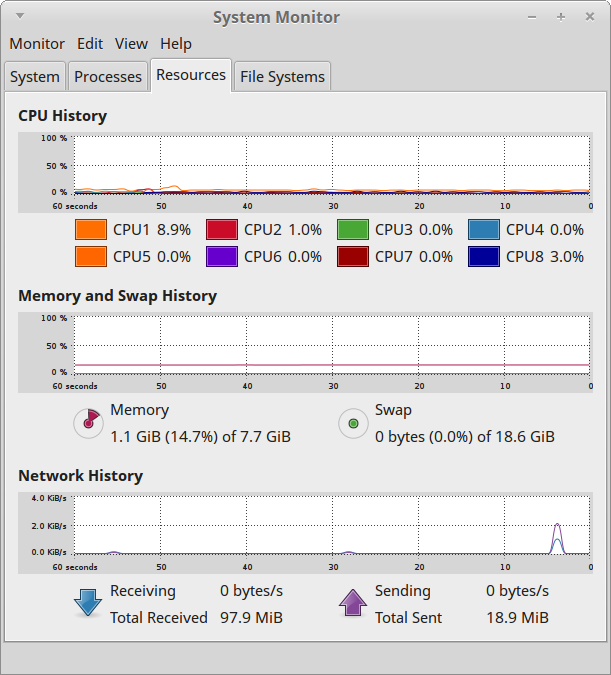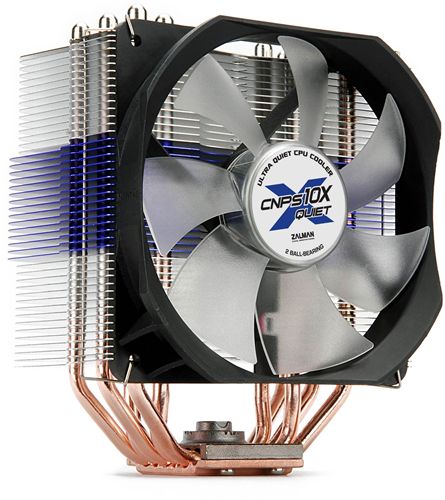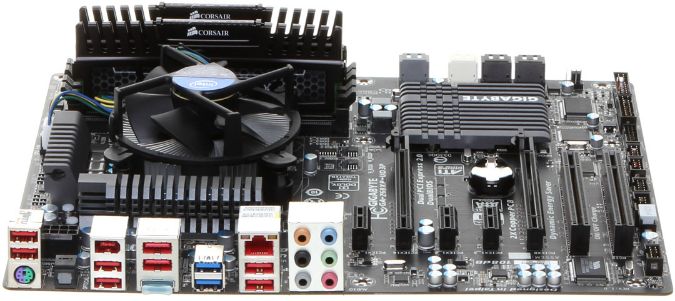BlackBeast
Named for its large, black, gaming case, BlackBeast Mark I was a Novatech bare-bones PC that I assembled at the end of 2010. Given that I rarely saw its AMD six-core 64-bit CPU exceed about 5% utilisation I remained vulnerable to the suggestion that I might have over-specified the system. A little bit. Possibly.1 On the other hand, it didn't tend to exceed 25C either. Given the propensity of the Windows operating "system" to sprawl over everything I fitted 8GB of DDR3 RAM for it to play with. About 1.2GB of this seemed to get soaked up effortlessly before I loaded and ran a single useful application.2
It was still available as of September 2011, though with an upgraded graphics chipset:
I also stuffed three 1TB SATA data drives, and a 150GB Velociraptor boot drive into it. Plus a Sapphire Radeon HD5670 passively-cooled graphics card, which purported to be about the most powerful available without a cooling fan. And a very decent Creative X-fi audio card (for its optical digital I/O).
Before going on...
... to describe the various metamorphoses BlackBeast has undergone in the last four-plus years, I'd better come clean. In mid-February 2015, its resident Windows Overlord fled the building without explanation (to start life anew as a Trainer of Performing Elephants, perhaps?). So I am now learning how to paddle gently in the tranquil pool of Linux Mint 17.1 — a change3 I have no particular objection to as I'm basically platform-agnostic. I use PCs to run programs that enable me to do the things I want to do, but couldn't do without a PC. I don't care what the underlying OS is. It's been my philosophy since CP/M on the Amstrad PCW, through RISC OS on the Acorn Archimedes, and back down into the swamp of Windows. (Ignoring my mad, brief, fling with OS-X of course.) A good OS is like good background music in a film. If you realise it's distracting you, it's failing.
Linux is not over-taxing BlackBeast...

... as much as Windows did, so I'm still open to the accusation of having over-specified the system. A little bit. Bite me. Indeed, you could fling the same accusation at me regarding the generous provision of SSDs inside the system case:

That trio of 480GB SSDs are more than enough local data storage space to be going on with, given that all the really heavy duty data files (the video and audio material) are kept well away from BlackBeast over on the 7TB of Synology RAID1 NAS.
BlackBeast Mark II
Owing to that delicious combination of my stupidity and clumsiness, in early December 2011 I managed to turn the AMD six-core CPU chip into a worthless piece of dead sand. How did that happen? Well, I had just begun experimenting with transcoding some of my DVDs into MP4 files. Such files are eminently suitable for playback on my Asus Tablet PC and equally suitable for storing on my Synology NAS and playing back on my Oppo Blu-ray and network media player.
Of course, it turns out that video transcoding is quite processor-intensive. I was using the jolly nice HandBrake application and I couldn't help noticing that not only did CPU cycles batter themselves against the 99% usage level but the processor chip temperature shot up as high as 77C during the process. Even with both case fans turned up to Harrier-take-off noise-level maximum speed.
Opinions among my technically savvy chums varied as to safe thermal limits, though all agreed that cooler is better. AMD tech support reckons 62C is the wise maximum to keep in mind. So I thought I'd investigate more efficient CPU cooling. I treated myself to a nice, big, quiet, Zalman. Expensive mistake...

It turns out size does matter, after all. Basically, having sliced into the patient to assess the lie of the land, the surgeon (me) had to close him up again4 and send him back into battle (as it were) with his original cooler. The Zalman was too large, in truth, for me to manoeuvre it into position without removing at least one — and probably two — of my four sticks of DRAM (permanently) and, even then, it was doubtful that the power cable cluster to the furthest corner of the motherboard would have enough "give" in it to get out of the way. (And the cable bundle was too fat to let me re-route it underneath the motherboard, too.)
I thus found myself back in Novatech's nicely-refurbished premises taking their advice on either a new processor or a new processor and motherboard combo and (in either case) a better, quieter, CPU cooler. AMD had an eight-core "Bulldozer" chip that tempted me (briefly), but I was advised to go for a quad core Intel i7 2600K with hyperthreading5 (whatever that means)...
... and we closed the deal when they agreed to fit this and a shiny new motherboard into my existing case, also fit (a different) Zalman — I didn't bother to bring along the one you can see above as I figured it was just too big — and also completely re-install a fresh copy of Windows 7 64-bit Ultimate SP1 leaving it up to me to configure and re-activate that using my own licence key when I'd got the system back home and after I'd re-fitted my data drives and graphics card. So I cooled my heels for about two hours while they re-opened the patient and performed the surgery. The two 4GB DRAM sticks are 20% faster than the four 2GB sticks I'd been using, too, and also leave two further memory slots free.
So now I have a faster, quieter, PC that barely gets up to 50C while video transcoding, and rips through CDs at about 30x real-time speed, too.
Inveterate tinkering
November 2012 update: I couldn't resist the bargain price upgrade from Windows 7 to Windows 8 Pro.
February 2013 updates: I couldn't resist the bargain price upgrade from 1TB SATA II (3Gb/s) drives to 3TB SATA III (6Gb/s) drives. Win8 Pro handles these (as data discs, at least) without blinking an eye. It would be a different story if I were to use one as the boot drive. I've also fitted a simple front panel unit with two USB3 ports on it. The connection for these was just sitting around on the motherboard, unused, while the two USB3 ports already provided on the back are truly awkward to get at.
March 2013 updates: a back panel PCI-Express card with two e-SATA ports on it, to use with the two (now-spare) 1TB SATA II drives. I've housed these in external enclosures with eSATA interfaces, and thus equipped my little toy with a further 2TB of usefully-nifty storage space. (SATA II isn't as fast as USB3, but it will do nicely.)
June 2013 updates: having retired the Buffalo Terastation NAS, the four 1TB SATA II drives it held are now housed in four USB3 caddies attached to BlackBeast through a seven-port USB3 powered hub. I've also stuck my 3TB backup USB3 drive on that hub. For my next trick, I'm about to retire the 150GB Velociraptor system drive (which I only recently realised is a SATA II device — I'd been vaguely bothered by the fact that it didn't yield anything like the speed increase I'd been rather hoping for). Its replacement is a 480GB SATA III SSD which should, I hope, speed things up quite considerably while keeping both the temperature and the noise down.
March 2014 updates: being firmly convinced after using my 480GB SATA III SSD as the system drive for more than half a year, I've just added a 240GB and two further 480GB SSDs into the mix. The pair of 3TB SATA III data drives thus rendered homeless are now in those two external e-SATA enclosures, ready as and when needed. It's now an essentially silent PC (the only remaining fan — the Zalman CPU fan — is just about audible if I put my ear right next to the case). The noisiest component is now the CD/DVD drive, though I only rarely need to use that.
June 2014 updates: I upgraded to the Sapphire AMD R7 250 Ultimate Fanless6 1GB graphics card. And I replaced the pair of 24" Dell screens by a pair of higher-resolution (2560x1440) ASUS PB278Q 27" screens. I'm sure I'll be able to put the extra 1,382,400 pixels per screen to good use. Assuming Win8.1Pro Update 1 can locate them all to switch them on and off. Reports (or howls of frustrated anguish) to follow in due course, no doubt.
January 2015 update: I belatedly discovered "Ultimate Fanless" is spiffy enough to drive a 4K display screen (3840x2160). So I replaced the two 27" screens by a dinky little Philips 40" screen. It's like having four Full HD displays without the hassle of four sets of power and signal connections to trip over and tangle up.
February 2015 update: The six virtual 4K desktops I now run under Linux Mint 17.1 MATE — it's a long story — is just extra gravy on the cake (or something like that).
March 2015 update: After only a few bits of cursing, I managed to squeeze a GeForce GTX970 graphics card into the space previously occupied by "Ultimate Fanless". This new beast boasts 5.2 billion transistors, more processing cores than would have fitted — in the 1970s — into ICL's huge machine room at the ICL Bracknell facility, and two fans which it promises not to spin unless things get really heated. So, although it's really a fairly hard-core gaming card, I don't expect to trigger much movement of hot air with it before the arrival of summer. And it's demonstrably better able to handle my 4K display screen. We shall see.

